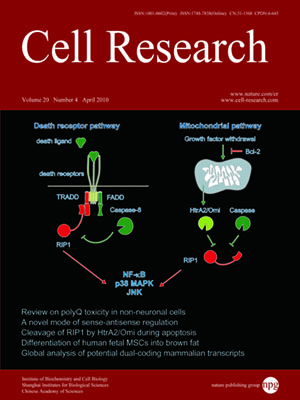
Volume 20, No 4, Apr 2010
ISSN: 1001-0602
EISSN: 1748-7838 2018
impact factor 17.848*
(Clarivate Analytics, 2019)
Volume 20 Issue 4, April 2010: 445-457
ORIGINAL ARTICLES
Length of the ORF, position of the first AUG and the Kozak motif are important factors in potential dual-coding transcripts
Heng Xu1,*, Ping Wang1,*, Yujie Fu1,*, Yufang Zheng3, Quan Tang1, Lizhen Si1, Jin You1, Zhenguo Zhang1, Yufei Zhu1, Li Zhou1, Zejun Wei1, Bin Lin1, Landian Hu1,2 and Xiangyin Kong1,2
1The Key Laboratory of Stem Cell Biology, Institute of Health Sciences, Shanghai Institutes for Biological Sciences, Chinese Academy of Sciences and Shanghai Jiao Tong University School of Medicine, 225 South Chong Qing Road, Shanghai 200025, China
2State Key Laboratory of Medical Genomics, Ruijin Hospital, Shanghai Jiaotong University, 197 Rui Jin Road II, Shanghai 200025, China
3Department of Physiology and Biophysics, School of Life Sciences, Fudan University, Shanghai 200433, China
Correspondence: Xiangyin Kong, Landian Hu,(xykong@sibs.ac.cn; ldhu@sibs.ac.cn)
A single mammalian transcript normally encodes one protein, but the transcript of GNAS (G-protein α-subunit) contains two reading frames and produces two structurally unrelated proteins, XLαs and ALEX. No other confirmed GNAS-like dual-coding transcripts have been reported to date, even though many such candidate genes have been predicted by bioinformatics analysis. In this study, we constructed a series of vectors to test how two protein products were translated from a single transcript in vitro. The length of the ORF (open reading frame), position of the first AUG and the Kozak motif were found to be important factors. These factors, as well as 55-bp NMD (nonsense-mediated mRNA decay) rule, were used in a bioinformatics search for candidate dual-coding transcripts. A total of 1307, 750 and 474 two-ORF-containing transcripts were found in human, mouse and rat, respectively, of which 170, 89 and 70, respectively, were found to be potential dual-coding transcripts. Most transcripts showed low conservation among species. Interestingly, dual-coding transcripts were significantly enriched for transcripts from the zinc-finger protein family, which are usually DNA-binding proteins involved in regulation of the transcription process.
Cell Research (2010) 20:445-457. doi: 10.1038/cr.2010.25; published online 16 February 2010
FULL TEXT | PDF
Browse 2221


